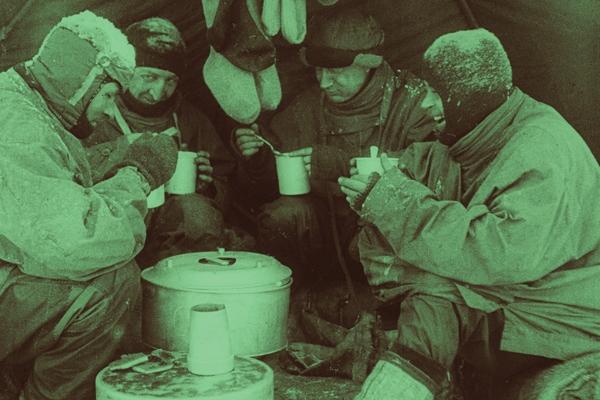For a while in the 1990s, the NASDAQ of polar exploration knocked Scott off his plinth and installed Shackleton as Britain’s favourite Antarctic hero. To a modern sensibility, survival seemed a more laudable pursuit than sacrifice. Better a live donkey, as Shackleton phlegmatically put it when turning home 90 miles from the South Pole, than a dead lion. For decades Scott has been comprehensively, even vindictively rubbished by the revisionist historian Roland Huntford. He was the one who pointed out that someone would have had to undo those tent ties for Oates to go outside and be some time, words he possibly never uttered anyway.
In recent years the Scott lobby have been fighting a rearguard action. Ranulph Fiennes’s biography used his own polar knowledge to argue that Scott was very far from an incompetent bungler. Antarctic meteorologists have weighed in with evidence that he had rum luck with the weather that southern summer. In 2006 the BBC Two series Blizzard: Race to the Pole reran the Scott-Amundsen race over comparable terrain in Greenland, equipping British and Norwegian teams with the clothing and gear that the original explorers would have used. At the end of every hard day on the ice – particularly hard for the Brits who were manhauling (the dogs did the donkey work for the Norwegians) - they also had to eat the high-fat sludge called pemmican. (I should declare an interest: I wrote the book that accompanied the series.)
And now James Cracknell has stepped in with his own take on the Scott story. His Great White Silence fell somewhere between Fiennes and Blizzard. Cracknell has done some of his own polar trudging for charity, so he is in a strong position to explain just how much of an improvement modern kit is. He went to the Scott Polar Research Institute in Cambridge to have a look at the heavy sledges and non-breathable windcheaters used by Scott. In the end, however, there’s very little new to say about the Terra Nova expedition these days. The main occasion for this film was the BFI’s fresh restoration of the footage shot in Antarctica by Scott’s cameraman, Herbert Ponting, released as The Great White Silence. It has a new score by Simon Fisher Turner which, while suitably chilly, can never eclipse Vaughan Williams's Sinfonia Antarctica, initially composed as the soundtrack for the 1948 film Scott of the Antarctic.
Watch the trailer for The Great White Silence
Ponting’s reputation has been slightly occluded in recent years too. As Shackleton’s star rose, so too did that of his Australian photographer Frank Hurley. Prints of his astonishing images of the Endurance cracking in the ice now go for many thousands. Unlike Ponting, Hurley was there for the duration and even dived through freezing water to rescue his precious photographic plates from a slowly sinking ship. Ponting left the hut at Cape Evans and came up onto the Great Ice Barrier (nowadays known as the Ross Ice Shelf) to capture on film Scott’s phalanx of sledges as they headed poignantly out into the white, Oates waving back cheerily. But he wasn’t there for the hard yards.
 Ponting's record of the Scott expedition thus has a cheerful, stage-managed quality. Hearty chaps smile at the camera as they demonstrate how to put up a tent, cook hoosh, make friends with a penguin (pictured right) - before, off camera, slaughtering it. Above all, the footage of men dragging a sledge in harness was used here to illustrate the dread progress up the Beardmore Glacier, by which time all the Siberian ponies which had dragged the food that far were slaughtered and the dogs sent home. Ponting’s sped-up film makes manhauling look like a stroll in the park: human carthorses putting on a pretence of struggle when the real struggle lay ahead. As a metabolic physiologist explained to Cracknell, you burn more than 6000 calories a day in harness. The five men who reached the Pole and turned for home 800 miles away were taking in no more than 4500. As was amply proved in Blizzard, their bodies started eating themselves.
Ponting's record of the Scott expedition thus has a cheerful, stage-managed quality. Hearty chaps smile at the camera as they demonstrate how to put up a tent, cook hoosh, make friends with a penguin (pictured right) - before, off camera, slaughtering it. Above all, the footage of men dragging a sledge in harness was used here to illustrate the dread progress up the Beardmore Glacier, by which time all the Siberian ponies which had dragged the food that far were slaughtered and the dogs sent home. Ponting’s sped-up film makes manhauling look like a stroll in the park: human carthorses putting on a pretence of struggle when the real struggle lay ahead. As a metabolic physiologist explained to Cracknell, you burn more than 6000 calories a day in harness. The five men who reached the Pole and turned for home 800 miles away were taking in no more than 4500. As was amply proved in Blizzard, their bodies started eating themselves.
That said, the film stock is endlessly absorbing. It has also been gloriously restored. Ponting’s colour-tinting of landscape shots produced ravishing dark pink skies and glistening yellow bergs. The human story is just as fascinating. When a wonderfully stiff, dinner-jacketed Ponting introduced his film 90 Degrees South, the ship journey featured stokers boxing on board, the Russian stable lad dancing athletically, ponies and huskies jamming the deck, Wilson having his hair clipped. It would have been lovely to see his powerful footage of killer whales hunting in packs here. (Ponting once found himself hauling his camera and tripod across breaking ice floes, being chased by hungry killers who must have mistaken him for a seal.)
Cracknell is a more natural expert than presenter, better without a script than with. The constraints of a Discovery Channel budget obliged him to be both. Aside from the film itself, the most impressive insights took the viewer viscerally back to Edwardian Antarctica as Cracknell inspected the desperately empty food bags found in the tent with the bodies of Scott, Wilson and Bowers. He also inspected the museum drawers where their geological samples, lovingly collected on the Beardmore and dragged across hundreds of miles, are now stored with white-paper labels.
In the end these tiny rocks were Scott’s intellectual fig leaf, the justification for losing a race he never knew he’d entered until Amundsen suddenly popped up in the South. Scott’s critics wonder why, when the going got tough, they didn’t dump his rocks to lighten the sledge. More pertinently, you wonder why they kept hold of Oates’s heavy sleeping bag long after he’d gone outside. There it was on screen, an empty husk of reindeer fur which a man once abandoned to give his sledge mates a better chance of survival.















Add comment